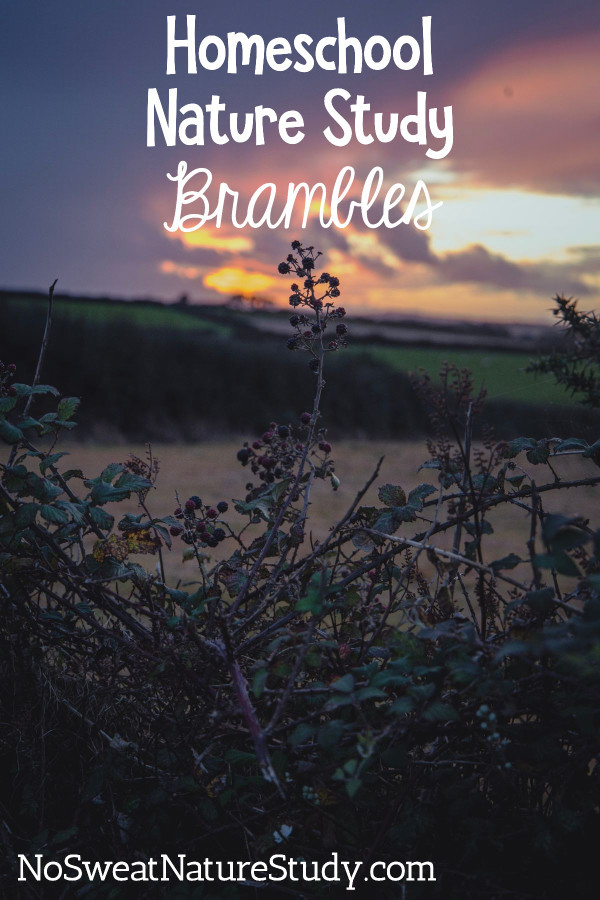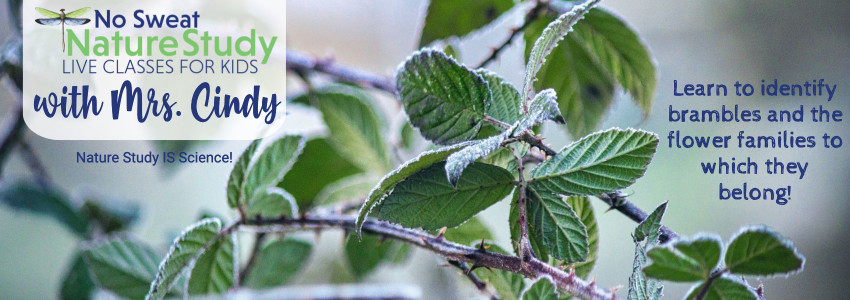A Bramble Nature Study for the Entire Family
Are you looking for a fun and educational activity to engage your children’s curiosity about prickly things in nature? Look no further than the latest episode of the No Sweat Nature Study podcast, where Mrs. Cindy teaches a bramble nature study.
Explore the fascinating world of blackberries and raspberries while discovering the science behind these prickly plants.

This post contains affiliate links.
Bramble Nature Study
Join Mrs. Cindy as she recounts experiences picking wild blackberries and raspberries on her farm. The very pointy prickles that line the stems of these plants sure can pose a challenge when trying to harvest the delicious aggregate fruits!
Those pesky prickles serve as a natural defense mechanism for each plant, deterring animals (including humans) from devouring the fruits and damaging the leaves and stems of the plants. Doesn’t it sound strange that plants need defensive mechanisms to protect themselves? Believe it or not, a surprising number of plants have prickles, as well as other amazing defensive tools!

Interestingly, these prickly vines and shrubs known as brambles are part of the rose family of plants. Yes, blackberries and raspberries are related to roses! Long, arching stems intertwined in a tangle give them a characteristic brambly look that’s unlike most other plants.
They can grow in many different places, including forests, fields, and along roadsides. You can even sometimes find them in gardens and parks. Brambles are often used by birds and other animals for nesting and to find a safe shelter among the sharp prickles.
Free Nature Observation Printable Packet for All Seasons
No matter what time of year you’re listening to this episode of the No Sweat Nature Study Podcast, here’s a printable pack of nature observation activities for every season of the year!
Bramble Nature Study Video Class
In the No Sweat Nature Study LIVE video class about brambles, you’ll learn so much more about the rose family of plants, specifically the Rubus genus. That’s the fancy scientific name for plants that are brambles!
You’ll get up close and personal with a few bramble plants and will identify their similarities and differences. Not only will you notice the physical characteristics, but you’ll create a nature journal page to show the similarities in the shrub structure, stems, leaves, flowers, and fruits!
Nature Walk Curriculum
The best way to learn more about bramble nature study is to join the No Sweat Nature Study Video Classes. If you’re not ready for membership yet, any of these curriculum guides can help you explore similar topics.
Understanding how to identify Flower Families opens up a new world of observation in nature study. You’ll love how easy it is to teach these identification and comparison skills in this fun curriculum!
Just how do plants protect themselves from herbivores and illnesses? You’ll be amazed at the many Defense Mechanisms of Plants! From thorns and poisons to stinky smells and self-destruction, plants are prepared for battle.
-
 Flower Families$20.00
Flower Families$20.00 -
 Defense Mechanisms of Plants$20.00
Defense Mechanisms of Plants$20.00
Links and Resources
Finding and identifying brambles is so much fun with either of the berry field guides listed below!
Summer Play Dough Mats
Download the new summer play dough mats to use as a fun, educational activity on hot summer afternoons!
Please leave a rating or a review on your podcast app! It helps the podcast to show up for more people…which means more families can enjoy science through the wonderful lens of nature study! Thank you!
Would you like to record a voicemail to answer this season’s nature study question?
At the end of each No Sweat Nature Study Podcast episode, Mrs. Cindy includes messages from a few of her friends. You have the opportunity to record a message that she might use on an upcoming episode!
All children must have their parent’s permission before leaving a recording. Parents are welcome to record an answer, too!
Each season, there will be a different question to answer. You can see this season’s question below. Think about your answer first and then follow these simple directions:
- Click the button that says “start recording”.
- Tell me your first name. (If you want to tell your age and/or where you live, feel free to do that, too.)
- You will have 60 seconds to answer the question, but try to be concise.
- Push the play button to listen to your recording before sending it to be sure it is recorded properly. If not, simply record it again.









